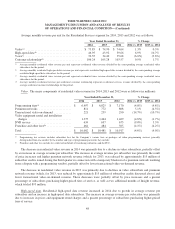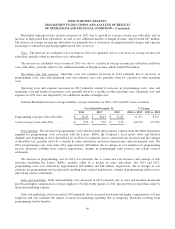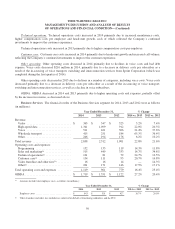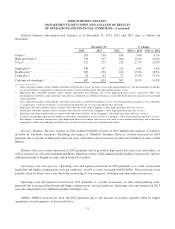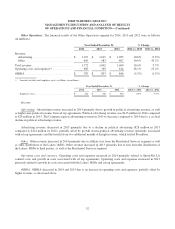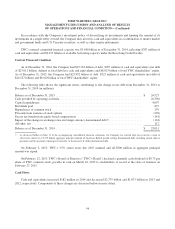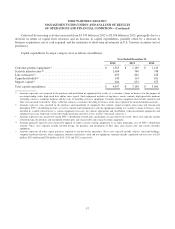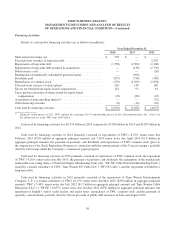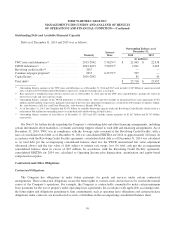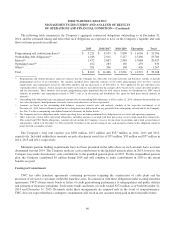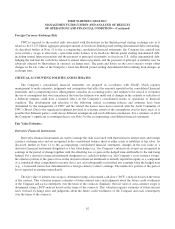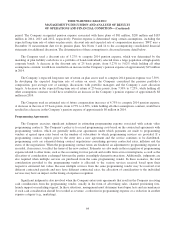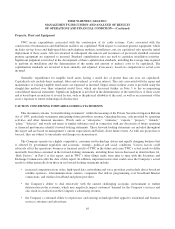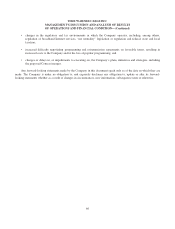Time Warner Cable 2014 Annual Report Download - page 65
Download and view the complete annual report
Please find page 65 of the 2014 Time Warner Cable annual report below. You can navigate through the pages in the report by either clicking on the pages listed below, or by using the keyword search tool below to find specific information within the annual report.
TIME WARNER CABLE INC.
MANAGEMENT’S DISCUSSION AND ANALYSIS OF RESULTS
OF OPERATIONS AND FINANCIAL CONDITION—(Continued)
Cash used by investing activities increased from $3.345 billion in 2012 to $3.476 billion in 2013, principally due to a
decrease in return of capital from investees and an increase in capital expenditures, partially offset by a decrease in
business acquisitions, net of cash acquired, and the maturities of short-term investments in U.S. Treasury securities (net of
purchases).
Capital expenditures by major category were as follows (in millions):
Year Ended December 31,
2014 2013 2012
Customer premise equipment(a) ................................. $ 1,565 $ 1,109 $ 1,143
Scalable infrastructure(b) ....................................... 1,004 740 748
Line extensions(c) ............................................ 695 602 428
Upgrades/rebuilds(d) .......................................... 149 114 101
Support capital(e) ............................................. 684 633 675
Total capital expenditures ..................................... $ 4,097 $ 3,198 $ 3,095
(a) Amounts represent costs incurred in the purchase and installation of equipment that resides at a customer’s home or business for the purpose of
receiving/sending video, high-speed data and/or voice signals. Such equipment includes set-top boxes, remote controls, high-speed data modems
(including wireless), telephone modems and the costs of installing such new equipment. Customer premise equipment also includes materials and
labor costs incurred to install the “drop” cable that connects a customer’s dwelling or business to the closest point of the main distribution network.
(b) Amounts represent costs incurred in the purchase and installation of equipment that controls signal reception, processing and transmission
throughout TWC’s distribution network, as well as controls and communicates with the equipment residing at a customer’s home or business. Also
included in scalable infrastructure is certain equipment necessary for content aggregation and distribution (video-on-demand equipment) and
equipment necessary to provide certain video, high-speed data and voice service features (voicemail, email, etc.).
(c) Amounts represent costs incurred to extend TWC’s distribution network into a geographic area previously not served. These costs typically include
network design, the purchase and installation of fiber optic and coaxial cable and certain electronic equipment.
(d) Amounts primarily represent costs incurred to upgrade or replace certain existing components or an entire geographic area of TWC’s distribution
network. These costs typically include network design, the purchase and installation of fiber optic and coaxial cable and certain electronic
equipment.
(e) Amounts represent all other capital purchases required to run day-to-day operations. These costs typically include vehicles, land and buildings,
computer hardware/software, office equipment, furniture and fixtures, tools and test equipment. Amounts include capitalized software costs of $323
million, $335 million and $296 million in 2014, 2013 and 2012, respectively.
57



